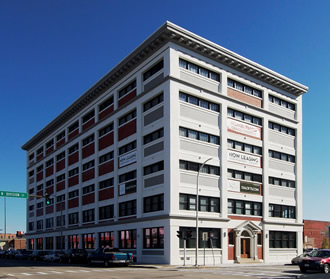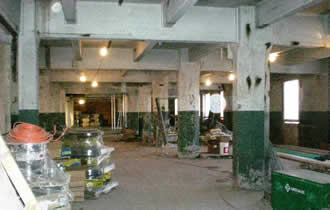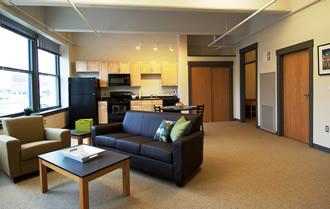Alling and Cory Warehouse

Alling and Cory Warehouse, 136 North Division Street, Buffalo, Erie County
The striking rehabilitation of the former Alling and Cory paper warehouse in downtown Buffalo powerfully demonstrates that historic properties are adaptable, renewable resources that offer cost effective and environment friendly development options. With the help of the federal and New York State historic rehabilitation tax credit programs administered by the state Office of Parks, Recreation and Historic Preservation, the vacant warehouse has been transformed into a vibrant apartment complex designed expressly for students. Located close to Erie Community College, the 105,000 square-foot building's heavy load bearing reinforced concrete structural system and open floor plan helped to facilitate its creative conversion.




The warehouse was built in 1910 for the Buffalo division of the Alling and Cory Company, a Rochester-based paper distributor that was founded in 1819. The company grew and prospered during the nineteenth and twentieth centuries and by 1948 it had facilities in nine states and 450 employees. Although the company continued to expand during the last half of the twentieth century, it was sold in 1996 to Union Camp Corporation during a period of corporate consolidation in the paper industry. The Buffalo warehouse was abandoned in 2001 when Union Camp, which became part of International Paper, moved to suburban Cheektowaga.
Designed by R.J. Reidpath and Sons, a regional architectural firm that specialized in industrial buildings, the Alling and Cory building is one of the finest examples of reinforced concrete warehouse construction in the city. At the beginning of the twentieth century, Buffalo was the eighth largest city in the United States and one of the nation's leading industrial centers. As a result, the city experienced an industrial building boom and many of its new factories and warehouses incorporated the "Daylight Factory" design, which utilized steel reinforced concrete to create strong, fireproof structural systems that supported concrete slab floors. The design featured large unobstructed floor spaces and exposed concrete exterior frames that could be filled with large windows to admit light and air. The Alling and Cory warehouse is an excellent example of a variation of the type adapted for paper storage, which requires less daylight than the typical factory.
Like many cities across the Northeast, Buffalo was hard hit by the massive exodus of industry, manufacturing, and people during the last half of the twentieth century. While the city still boasts an extraordinary architectural legacy, it has also suffered from the loss of historic properties as well as a large number of vacant and/or underused buildings in need of repair and reuse. While finding sustainable solutions for these properties is a tremendous challenge, an expanding group of private individuals, businesses, organizations, and local officials are striving to reverse this trend through a variety of creative redevelopment projects.
The warehouse was rehabilitated by Schneider Development LLC and listed on the State and National Registers of Historic Places so it could qualify for the state and federal tax credits. The project effectively combined preservation with new construction and energy saving technology. Eighty-eight, fully furnished apartments now fill the former warehouse, and many original features have been incorporated into the new design, including the principal staircase, exposed concrete support columns and ceiling beams, and a section of a large spiral package chute displayed in the lobby. The NYS Energy Star-rated building boasts a high performance, state-of the-art heating and cooling system, and a reflective roof that reduces air-conditioning costs in the summer. The property also features an onsite grocery store, spacious recreation and study areas, and a laundry room linked to the building's website that monitors the availability of washing and drying machines.
Unlike other residential projects completed in downtown Buffalo over the past several years, the Lofts @ 136 serve the area's large student population, helping to draw younger people to the center of the city and its many attractions. The project also underscores that the adaption of existing buildings for alternate uses is the "greenest," most environmentally sensitive approach to sustainable community development today.